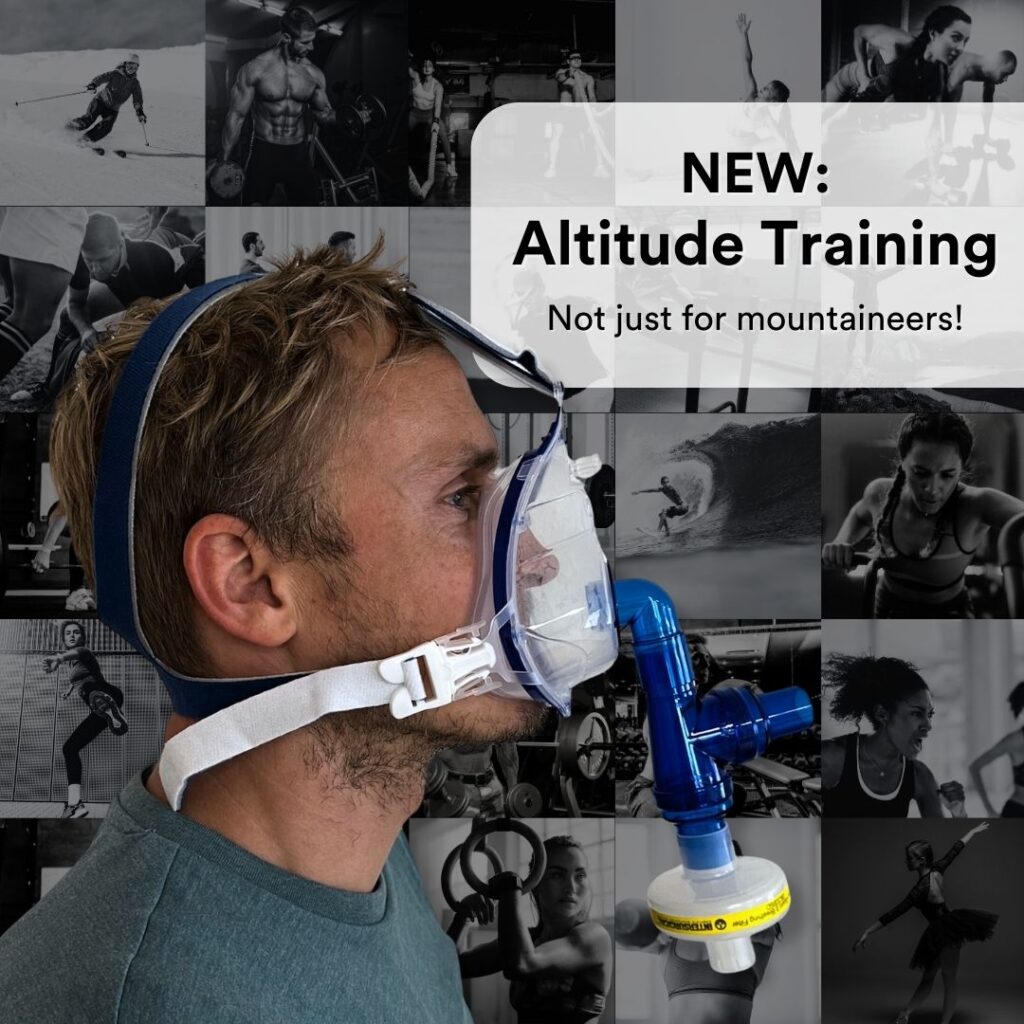
Welcome, oxygen enthusiasts and thrill-seekers alike, to the exhilarating world of Altitude Training! Get ready to push your limits, defy gravity and dive into the fascinating realm where every breath counts. So, buckle up as we embark on a journey through the heights and depths of everything you need to know about Altitude Training including: what it is, how it works, the benefits and who can benefit from it.
As Altitude Training is relatively new and innovative to the scientific and longevity community, a lot of people might not have even heard of it or aware of how it works and its vast array of benefits.
Altitude Training (also known as Intermittent Hypoxic Training) is a technique that involves exposing the body to alternating patterns of low-oxygen (hypoxic) and normal-oxygen (normoxic) air as well as high oxygen levels (hyperoxia). This procedure may be repeated several times throughout your session. Typically, you will remain stationary throughout the session with a mask over their nose and mouth and they will continue breathing as normal. However, if you wish to take your training a step further, there are machines that allow you to perform intense sporting activities such as running on a treadmill while breathing into the oxygen mask.
This cycling of oxygen levels prompts the body to adapt in various ways, such as increasing the production of blood cells and improving oxygen utilisation efficiency. Essentially, Altitude Training ‘tricks’ your body into thinking that it is climbing a mountain, or experiencing something with low oxygen levels. This is why it very much feels like real-life altitude training. When you breathe in this low-oxygen air, your body has to work harder in order to receive the oxygen that it needs. Overtime, your body becomes significantly more efficient in using oxygen effectively. Think of it as training a specific muscle, the more you work it over time, the stronger the muscle gets.
Some of the benefits of Altitude Training include:
- Enhanced oxygen utilisation: Altitude Training improves the body’s ability to utilise oxygen efficiently.
- Cardiovascular fitness improvement: Altitude Training enhances cardiovascular fitness and endurance through high-altitude simulation.
- Performance enhancement: Altitude Training improves oxygen-carrying capacity, benefiting athletes and individuals seeking performance enhancement.
- Overall wellness promotion: Altitude Training improves oxygen circulation, leading to increased energy levels and improved cognitive function.
- Potential anti-ageing effects: Altitude Training supports cellular regeneration and reduces oxidative stress, potentially contributing to anti-ageing benefits.
For those of you who are already familiar with Altitude Training, you might have fallen victim to a common misconception about it. Although professional mountain climbers and those who are training do benefit greatly from Altitude Training, they are not the only ones who can benefit from it.
The truth is, anyone can benefit from Altitude Training. Here are just a few groups of people who benefit from it:
Athletes: Athletes enjoy participating in Altitude Training as it helps them boost their endurance and performance. When they train in an environment with less oxygen, it makes their bodies more efficient in using oxygen. This means their hearts and lungs become stronger, and they can keep going for longer without getting tired. So, whether they’re running marathons, cycling for miles, swimming laps, or doing any endurance activity, Altitude Training helps them perform better.
Fitness Enthusiasts: People committed to their fitness objectives, might discover all of the Altitude Training advantages. By exposing their bodies to low-oxygen conditions challenges them, potentially ramping up their metabolism, enhancing heart health and amplifying calorie burn during exercise sessions.
Rehabilitation Patients: Some research indicates that Altitude Training could offer therapeutic advantages for specific medical conditions like cardiovascular disease, chronic obstructive pulmonary disease (COPD), and metabolic disorders. This training method may enhance oxygen transport efficiency, respiratory function and overall cardiovascular health among individuals dealing with these health conditions/concerns.
High-altitude adventurers: People who are gearing up for treks or climbs in high-altitude regions might employ the help of Altitude Training as a preparatory measure to adapt their bodies to lower oxygen levels anticipated during their adventures. This preparation can reduce the likelihood of altitude sickness and enhance both performance and comfort levels during high-altitude expeditions.
Health-conscious individuals: Many individuals may consider Altitude Training for its possible health advantage and to improve overall wellness.
Click here to register your interest and be the first to hear about our special offers!
FAQs:
What is Altitude Training?
Altitude Training (also known as Intermittent Hypoxic Training) is a technique that involves exposing the body to alternating patterns of low-oxygen (hypoxic) and normal-oxygen (normoxic) air as well as high oxygen levels (hyperoxia).
How long are the Altitude Training Sessions?
Sessions last up to 40 minutes. However, if you wish, you are able to stop the session at any given time,
What are the benefits of Altitude Training?
Benefits of Altitude Training include:
- Enhanced oxygen utilisation
- Cardiovascular fitness improvement
- Performance enhancement
- Overall wellness promotion
- Potential anti-ageing effects
Who can benefit from Altitude Training?
One of the amazing assets of Altitude Training is that anyone can benefit from it! We have seen extreme popularity with those who are trained athletes, fitness enthusiasts, rehabilitation patients, senior citizens as well as high-altitude adventurers!
How often do you have to do Altitude Training to see results?
We recommend a total of 10 sessions. However, it depends on the individual’s desired results.
How do you train for altitude?
Other than climbing up to the altitude you desire, the only other way to prepare for the altitude is through Altitude Training. By exposing the body to alternating patterns of low-oxygen (hypoxic) and normal-oxygen (normoxic) air as well as high oxygen levels (hyperoxia), Altitude Training ‘tricks’ your body into thinking that it is climbing a mountain, or experiencing something with low oxygen levels.
Is Altitude Training legal?
Yes.
Does Altitude Training improve performance?
Yes Altitude Training can improve performance, especially endurance sports. When athletes train at high altitudes where oxygen levels are lower, their bodies adapt by producing more red blood cells and increasing their oxygen-carrying capacity, known as acclimatisation. This can lead to several performance benefits such as: enhanced endurance, improved recovery, increased speed and mental toughness.


